Balance of Payments (BoP) Developments in 2005-06 - ఆర్బిఐ - Reserve Bank of India


Balance of Payments (BoP) Developments in 2005-06
The preliminary data compiled for the Q4 (i.e., January-March 2006), in conjunction with the partially revised data for the first three quarters (i.e., April-June, July-September and October-December 2005) provide an assessment of the BoP for the period April-March 2005-06. Full details of BoP data are set out in the enclosed Statements in the standard format of presentation.
January-March 2006
The major items of the BoP for Q4 of 2005-06 are presented in Table 1 below.
|
Table 1: India's Balance of Payments: January-March 2006 |
|||||
|
(US $ million) |
|||||
|
Items |
April-June |
July-Sept. |
Oct.-Dec. |
Jan.-March |
Jan.-March |
|
|
2005PR |
2005PR |
2005PR |
2006 P |
2005 PR |
|
1 |
2 |
3 |
4 |
5 |
6 |
|
Exports |
24,150 |
24,060 |
26,400 |
30,170 |
24,547 |
|
Imports |
37,754 |
38,692 |
38,237 |
41,651 |
34,676 |
|
Trade Balance |
-13,604 |
-14,632 |
-11,837 |
-11,481 |
-10,129 |
|
Invisibles, net |
10,048 |
9,587 |
8,011 |
13,296 |
10,656 |
|
Current Account Balance |
-3,556 |
-5,045 |
-3,826 |
1,815 |
527 |
|
Capital Account* |
4,803 |
10,301 |
-846 |
11,406 |
12,102 |
|
Change in Reserves# |
-1,247 |
-5,256 |
4,672 |
-13,221 |
-12,629 |
|
*: Including errors and omissions. #: On BoP basis excluding valuation. |
|
||||
|
P: Preliminary PR: Partially Revised. |
|||||
- India’s Merchandise exports, on a BoP basis, posted a robust growth (22.9 per cent) in Q4, as compared with a year ago (20.7 per cent) on account of a more broad-based export growth. The month-wise movement in exports as per Directorate General of Commercial Intelligence and Statistics (DGCI&S) data is presented in Chart 1.
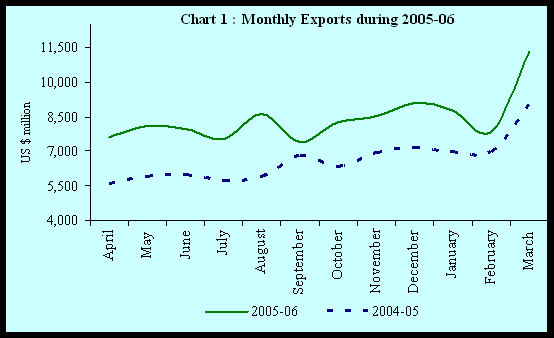
- Buoyant growth in invisibles receipts led by software (40.7 per cent) and private transfers (16.9 per cent) in January-March 2006 over the corresponding period of the previous year.
- Growth in imports decelerated from 59.1 per cent in January-March 2005 to 20.1 per cent in January-March 2006.
- Growth in exports recorded an improvement from 20.7 per cent in January-March 2005 to 22.9 per cent in January-March 2006.
- In the capital account, net flows under external commercial borrowings, foreign direct investment, portfolio investment and NRI deposits showed robust growth.
- Accretion to foreign exchange reserves (excluding valuation) stood at US $ 13.2 billion as compared to US $ 12.6 billion in the corresponding quarter of the previous year.
2005-06 (April-March)
The BoP position for 2005-06 has been worked out taking into account the partially revised data for the first three Quarters and the preliminary data for Q4. As mentioned earlier, the detailed data are set out in Statements 1 and 2. The major items are presented in Table 2.
|
Table 2 : India's Balance of Payments: 2005-06 (April-March) |
||
|
(US $ million) |
||
|
Items |
2005-06P |
2004-05PR |
|
1 |
2 |
3 |
|
Exports |
104,780 |
82,150 |
|
Imports |
156,334 |
118,779 |
|
Trade Balance |
-51,554 |
-36,629 |
|
Invisibles, net |
40,942 |
31,229 |
|
Current Account Balance |
-10,612 |
-5,400 |
|
Capital Account* |
25,664 |
31,559 |
|
Change in Reserves# |
-15,052 |
-26,159 |
|
(- Indicates increase) |
|
|
|
*: Including errors and omissions. #:
On BoP basis excluding valuation. |
||
- Maintaining a high export growth trajectory, merchandise exports, on BoP basis, recorded a growth of 27.5 per cent during 2005-06 (23.9 per cent in 2004-05). The commodity-wise break up, as per DGCI&S data, revealed that manufacturing exports led the growth momentum, with transport equipment, machinery and instruments, woolen yarn, fabrics and readymade garments, basic chemicals and pharmaceuticals and petroleum products emerging as the key drivers.
- Similarly, merchandise import payments maintained high growth (31.6 per cent) in 2005-06.
- According to DGCI&S data, the rise in petroleum, oil and lubricants (POL) imports (47.3 per cent) in 2005-06 showed the impact of steep rise in international crude oil prices. The average price of the Indian basket of international crude (a mix of Dubai and Brent varieties) rose to US $ 55.4 per barrel in 2005-06 from US $ 38.9 per barrel in 2004-05 (Chart 2).
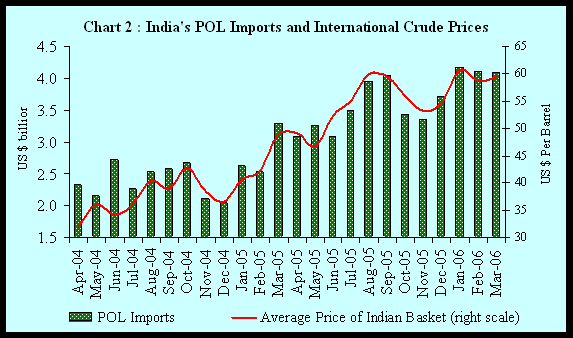
- Non-oil import payments growth at 20.5 per cent continued to signify underlying momentum, although moderated from a high growth phase of 2004-05 (41.8 per cent). The key components of non-oil imports were primarily the export related items and capital goods, signifying the growth in domestic industrial activity.
- On BoP basis, the large import payments led to expansion in trade deficit to US $ 51.6 billion in 2005-06 as compared with US $ 36.6 billion in 2004-05 (Chart 3).
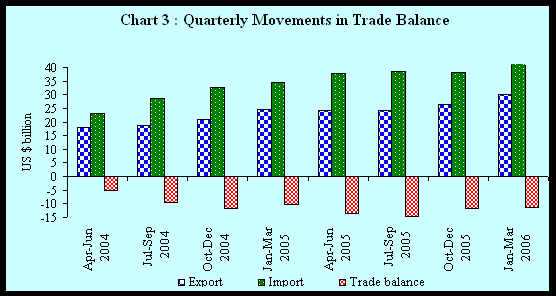
- While invisibles receipt rose by 27.3 per cent, invisibles payment posted a growth of 24.4 per cent, resulting in a higher invisibles surplus of US $ 40.9 billion as compared with US $ 31.2 billion in 2004-05 (Table 3).
|
Table 3: Invisibles Gross Receipt and Payment: 2005-06 |
||||
|
|
|
|
(US $ million) |
|
|
Items |
Invisibles Receipt |
Invisibles Payment |
||
|
|
2005-06P |
2004-05PR |
2005-06P |
2004-05PR |
|
1 |
2 |
3 |
4 |
5 |
|
I. Services |
60,610 |
46,031 |
38,345 |
31,832 |
|
Travel |
7,789 |
6,495 |
6,421 |
5,510 |
|
Transportation |
6,277 |
4,798 |
7,394 |
4,539 |
|
Insurance |
1,042 |
909 |
985 |
722 |
|
Govt. not included elsewhere |
305 |
328 |
480 |
261 |
|
Miscellaneous |
45,197 |
33,501 |
23,065 |
20,800 |
|
Of Which: Software |
23,600 |
17,200 |
1,338 |
674 |
|
II. Transfers |
25,220 |
21,276 |
944 |
432 |
|
III. Income (i+ii) |
5,651 |
4,547 |
11,250 |
8,361 |
|
(i) Investment Income |
5,477 |
4,431 |
10,504 |
7,100 |
|
(ii) Compensation of |
174 |
116 |
746 |
1,261 |
|
Total (I+II+III) |
91,481 |
71,854 |
50,539 |
40,625 |
|
P: Preliminary. PR: Partially Revised. |
||||
- The major components of invisibles receipt are the software exports and private transfers, comprising primarily remittances from Indians working overseas (Chart 4).
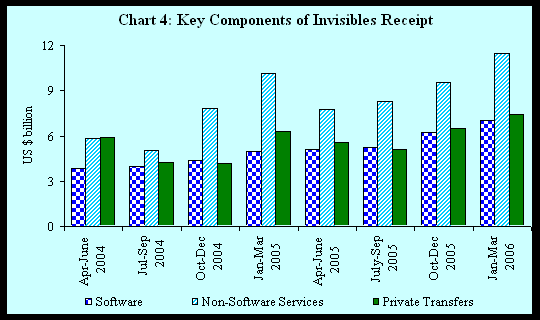
- Increase in invisibles payment mainly due to increase in payments relating to investment income due to one-off effect of IMD interest payments, transportation services and other business and technology related services.
- Despite a large trade deficit (US $ 51.6 billion), a net invisibles surplus of US $40.9 billion helped containing the current account deficit to US $ 10.6 billion in 2005-06 (Chart 5).
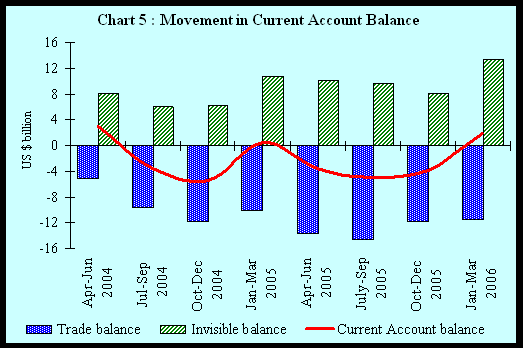
- In the Capital Account, the net flow under foreign direct investment, portfolio investment and NRI deposits recorded significant increase in 2005-06 while other capital flows including those of external assistance and external commercial borrowings showed moderation (Table 4).
|
Table 4: Net Capital Flows during 2005-06 |
||
|
(US $ million) |
||
|
Items |
2005-06P |
2004-05PR |
|
1 |
2 |
3 |
|
Foreign Direct Investment |
5,733 |
3,240 |
|
Portfolio Investment |
12,489 |
8,907 |
|
External Assistance |
1,438 |
1,923 |
|
External Commercial Borrowings |
1,591 |
5,040 |
|
NRI Deposits |
2,789 |
-964 |
|
Other Banking Capital* |
-1,416 |
4,838 |
|
Short-term Credits |
1,708 |
3,792 |
|
Others |
361 |
4,251 |
|
Total |
24,693 |
31,027 |
|
* Comprises foreign assets
of banks, foreign liabilities of banks (other than NRI deposits) and |
||
- Net FDI inflows to India picked up on sustained interest in India as an attractive investment destination due to strong economic activity and continued strength of the corporate sector with inflows channeling into manufacturing, business and computer services.
- The FII inflows remained buoyant in 2005-06, extending the phase of high FII inflows continuing for the past two years. The strong corporate earnings growth over the past several quarters and expectations of continuance of high growth phase maintained FII interest in Indian markets.
- ADR/GDR issuances also remained buoyant as booming stock markets offered corporates the opportunity to issue equities abroad.
- NRI deposits showed a significant turnaround from net outflows in the previous year.
- Net accretion to foreign exchange reserves (excluding valuation) stood at US $ 15.1 billion during 2005-06 (US $ 26.2 billion in 2004-05) (Chart 6).
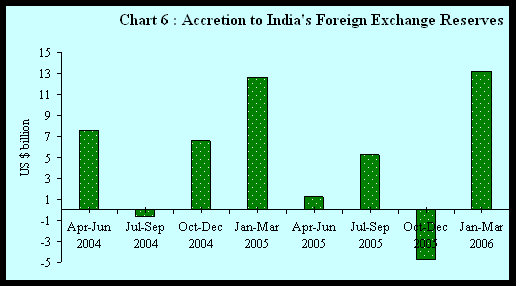
- The outstanding foreign exchange reserves stood at US $ 151.6 billion at the end of March 2006, placing India as the fifth largest holder of reserves among the emerging markets and sixth largest in the world.
Full details of quarterly and annual data for 2005-06 are set out in the standard format of presentation in the enclosed Statements 1 and 2.
Partial Revisions in BoP data for the first three quarters of 2005-06
According to the Revision Policy announced on September 30, 2004, the data for Q1, Q2 and Q3 of 2005-06 are to be revised. The BoP data have been accordingly revised based on the revised information reported by various reporting entities. The revised data are presented in Statements 1 and 2.
Alpana Killawala
Chief General Manager
Press Release : 2005-2006/1708






















